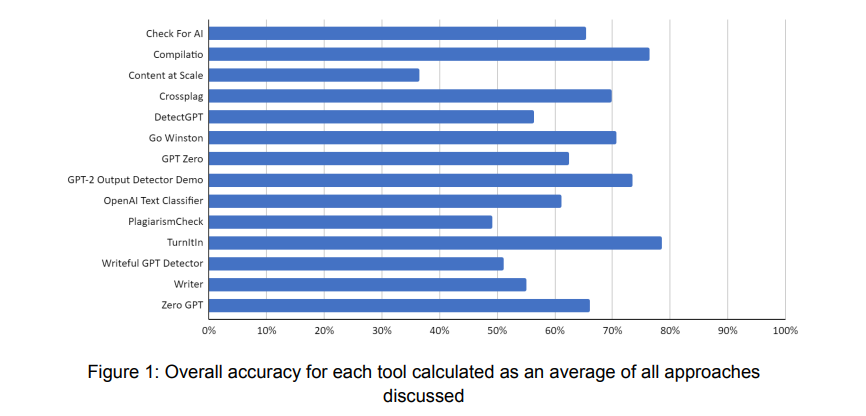⚡ Quick Answer: At the moment, we don’t know of any tool that can detect AI content with 100% accuracy.
However, there are several available tools that claim to have this ability. They analyze the style and various characteristics of the text to determine whether it’s written by AI or a human.
You just need to input your text into one of these detectors, and it will analyze and provide feedback on whether the content is AI-generated, often indicating the probability in terms of percentage.
Our AI Content Checker also has this function.
Technical Feasibility of Content Detection
Despite some counter-statements, the detection of AI-generated content by AI-powered detection tools is technically possible. Although accuracy levels and detection methods vary across mainstream AI content detectors, third-party studies support the feasibility of AI output detection in general.
In this context, it is important to understand that AI content detectors, while employing AI algorithms and NLP techniques, operate on the following main principle:
- A typical AI content detector employs a detection model that is trained on an extensive dataset of known AI-generated content.
- This model identifies unique patterns and characteristics associated with such content.
- By comparing the analyzed text with the detection model, the AI text detector then makes a judgment as to whether the content was generated by AI or created by a human.
High Accuracy Claims: Myth or Reality?
One of the most crucial points was and remains how accurate AI detectors can be and can they back up the claims of being highly accurate.
Due to the fast-evolving nature of AI language models, AI detectors simply can’t guarantee 100% accuracy. In addition, detectors use different datasets to train on. As a result, they usually produce results differing from each other.
A recent independent study conducted jointly by a group of academics found that the AI tools were quite accurate in detecting human-written texts (96% accuracy on average).
However, the accuracy for unedited AI-generated textual content was 74% and decreased further to 42% for manually edited or paraphrased texts.
The study group tested 14 AI detection tools and, among other things, determined the following average accuracy of these tools.

Ultimately, the research group put forward fairly negative conclusions:
This paper exposes serious limitations of the state-of-the-art AI-generated text detection tools and their unsuitability for use as evidence of academic misconduct. Our findings do not confirm the claims presented by the systems. They too often present false positives and false negatives. Moreover, it is too easy to game the systems by using paraphrasing tools or machine translation. Therefore, our conclusion is that the systems we tested should not be used in academic settings.
Testing of Detection Tools for AI-Generated Text by Debora Weber-Wulf, 2023
Widely Used AI Detectors
AI content detection tools are advanced AI-powered tools that serve to identify whether a piece of content has been generated using AI tools such as ChatGPT, Bard, and others.
These tools are specifically designed to analyze large volumes of content, detect duplicates or plagiarism, identify paraphrased content, and flag inappropriate material.
Here are some of the widely used AI content detection tools:
- Winston AI
- Copyleaks
- Content At Scale
- Originality AI
- AI Content Checker
- Undetectable AI
- GPTZero
- Crossplag
Implementation
Using AI content detectors is a straightforward and simple process. The following steps to detect AI content are pretty much similar across the majority of AI detectors:
- Go to an AI detector website and create an account.
- Upload the AI-generated text you want to check. Usually, AI detectors have dedicated text boxes for this purpose.
- Click on the “Analyze” or “Check” button.
- AI detection tool will analyze the text and provide a report indicating whether or not the text is likely to have been generated by an AI. It shows the AI usage probability in the percent value.
- Users can also view a more detailed report that shows how an AI detector calculated its score.

In addition to the simple method above, some AI tools are capable of checking AI content directly from a web page. In particular, AI Content Checker extension is capable of helping with such on-page content checking straight in your browser.

To help users bypass AI content further, many AI detection tools also offer so-called “text humanizer” tools that convert AI-written content into human-like text.
Brief Summary:
Detecting AI-written content using AI detectors is relatively uncomplicated and it is important to be aware of potential risks associated with this practice. AI-generated content can be identified with a good degree of accuracy if you follow the suggestions above,
Nevertheless, it is recommended to be cautious when using detection tools as they can sometimes be unreliable and are not the bulletproof solution. You can also apply common sense and identify a lack of style variety, fact-checking, repetitiveness, etc.

